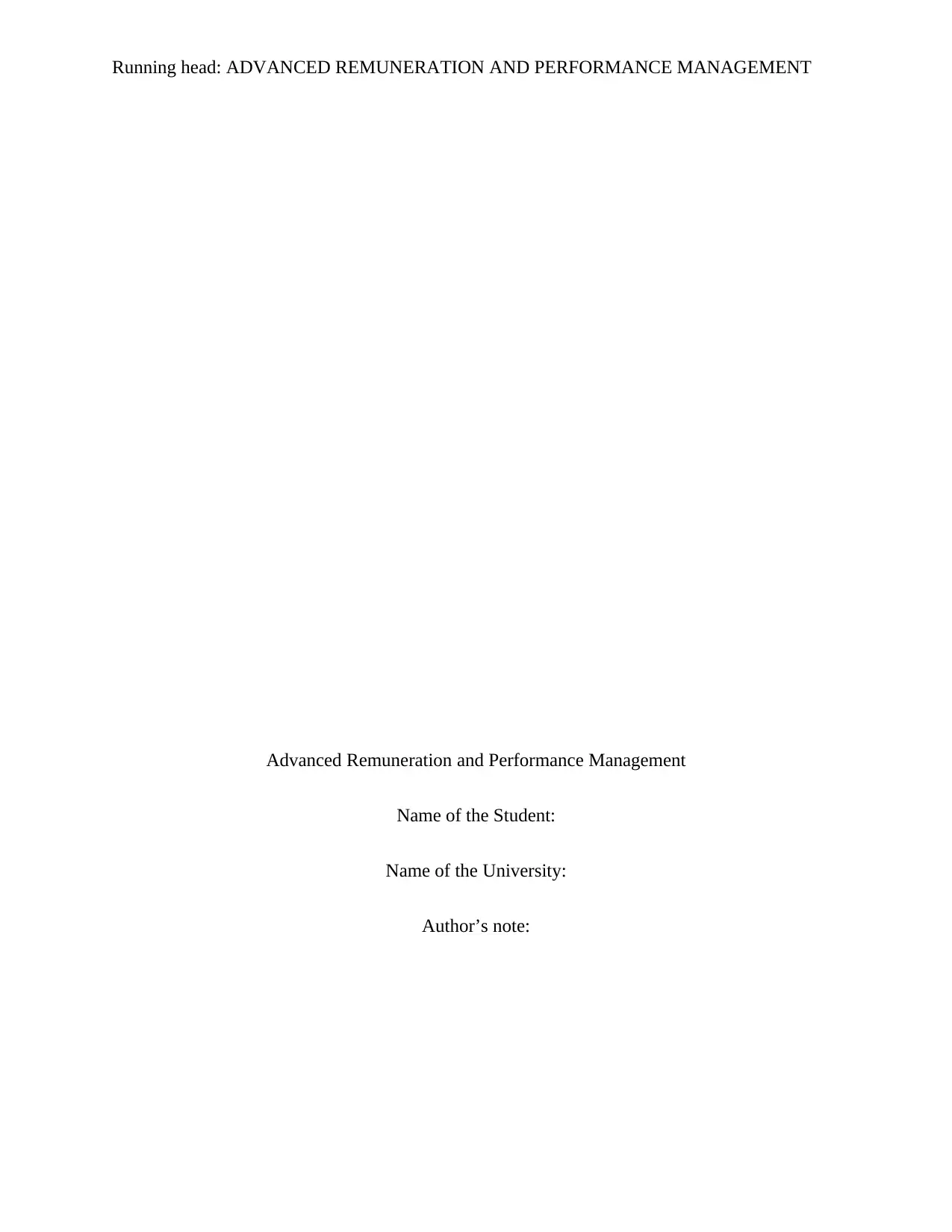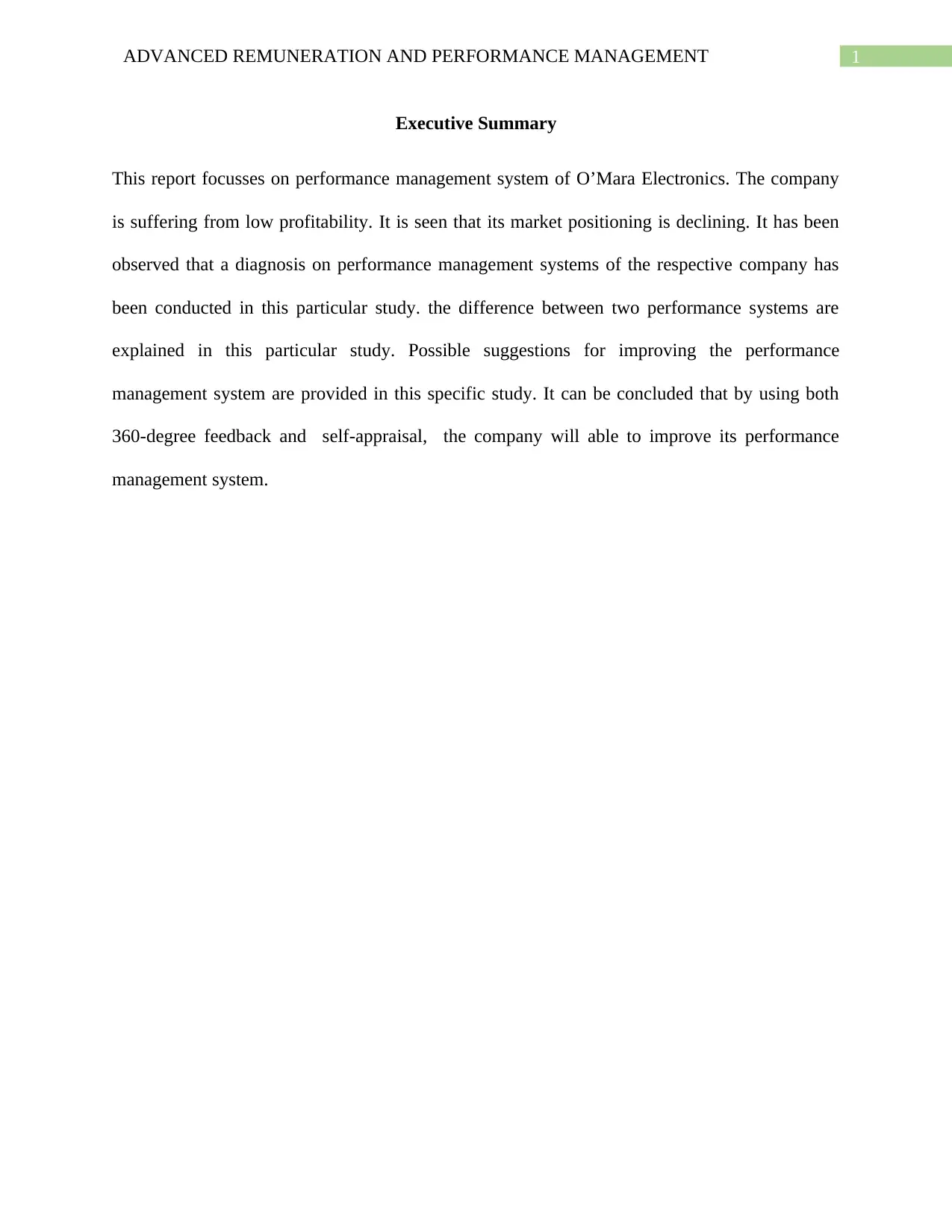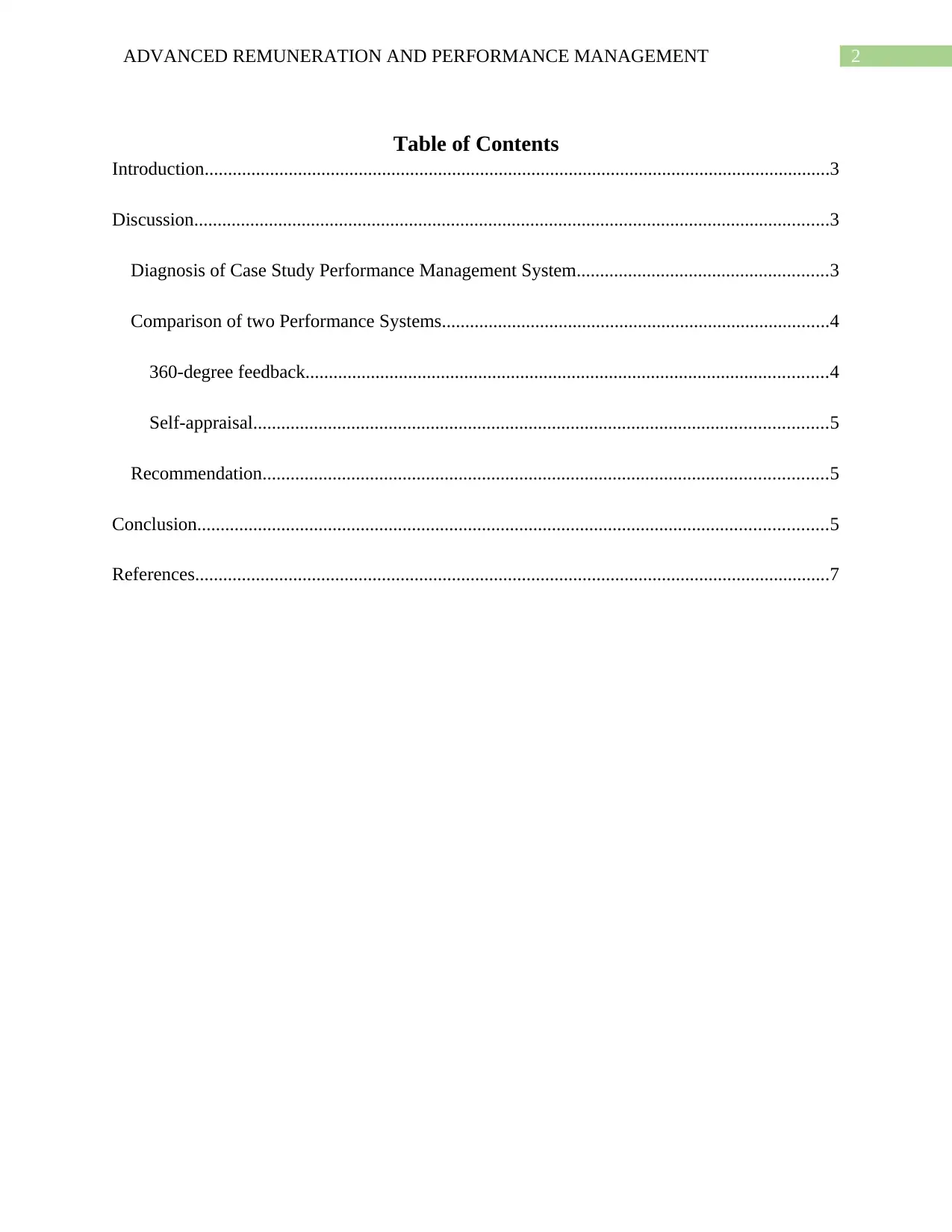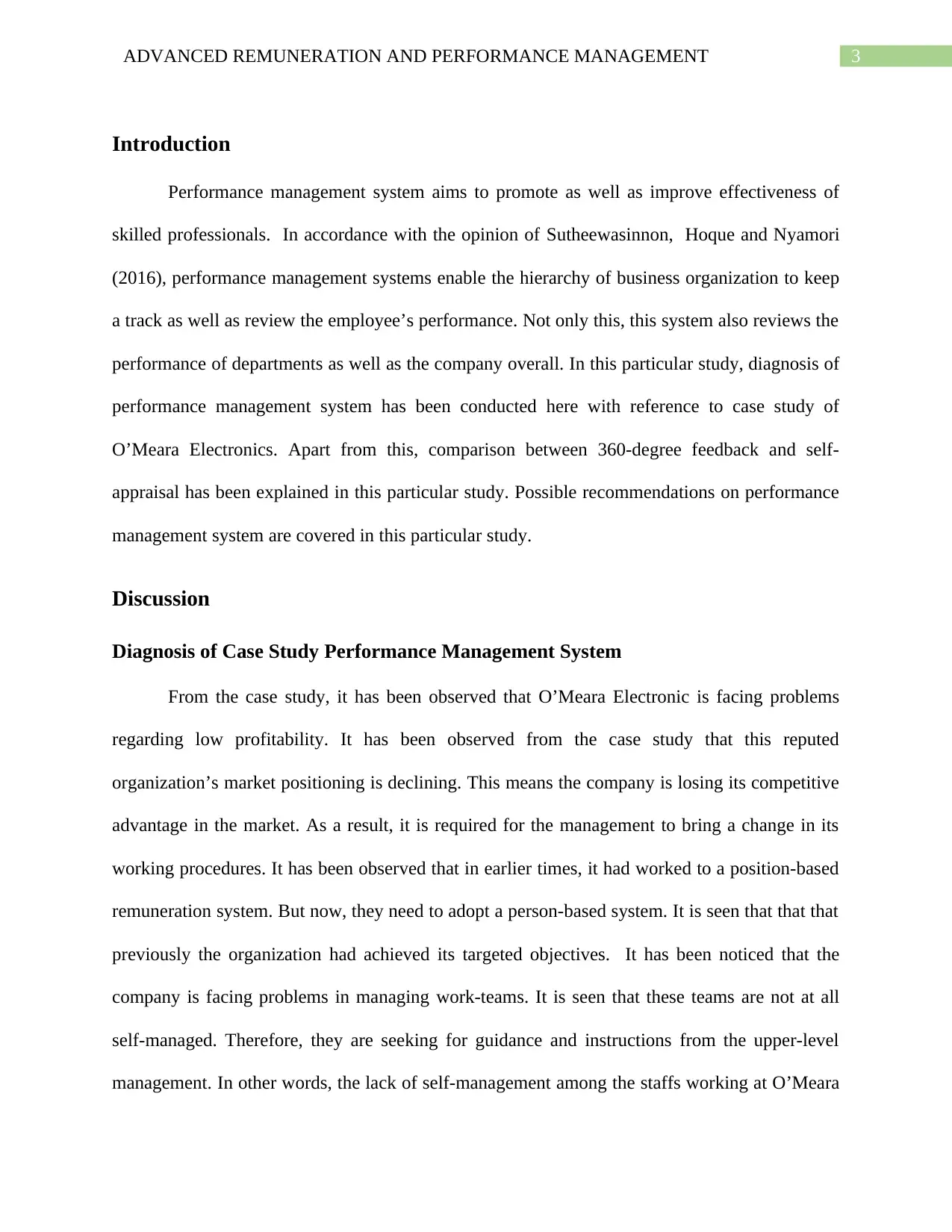MGT5ARP: Improving Performance at O'Meara Electronics - A Report
VerifiedAdded on 2023/06/11
|10
|2003
|263
Report
AI Summary
This report diagnoses the performance management system of O'Mara Electronics, a company facing declining profitability and market position. It identifies issues such as a lack of alignment between individual performance and company goals, ineffective teamwork, and insufficient incentive programs. The report compares 360-degree feedback and self-appraisal systems, recommending the implementation of both to enhance employee self-awareness and organizational understanding. By adopting these systems, O'Meara Electronics can improve its market position, productivity, and profitability, ultimately maintaining a competitive advantage.

Running head: ADVANCED REMUNERATION AND PERFORMANCE MANAGEMENT
Advanced Remuneration and Performance Management
Name of the Student:
Name of the University:
Author’s note:
Advanced Remuneration and Performance Management
Name of the Student:
Name of the University:
Author’s note:
Paraphrase This Document
Need a fresh take? Get an instant paraphrase of this document with our AI Paraphraser

1ADVANCED REMUNERATION AND PERFORMANCE MANAGEMENT
Executive Summary
This report focusses on performance management system of O’Mara Electronics. The company
is suffering from low profitability. It is seen that its market positioning is declining. It has been
observed that a diagnosis on performance management systems of the respective company has
been conducted in this particular study. the difference between two performance systems are
explained in this particular study. Possible suggestions for improving the performance
management system are provided in this specific study. It can be concluded that by using both
360-degree feedback and self-appraisal, the company will able to improve its performance
management system.
Executive Summary
This report focusses on performance management system of O’Mara Electronics. The company
is suffering from low profitability. It is seen that its market positioning is declining. It has been
observed that a diagnosis on performance management systems of the respective company has
been conducted in this particular study. the difference between two performance systems are
explained in this particular study. Possible suggestions for improving the performance
management system are provided in this specific study. It can be concluded that by using both
360-degree feedback and self-appraisal, the company will able to improve its performance
management system.

2ADVANCED REMUNERATION AND PERFORMANCE MANAGEMENT
Table of Contents
Introduction......................................................................................................................................3
Discussion........................................................................................................................................3
Diagnosis of Case Study Performance Management System......................................................3
Comparison of two Performance Systems...................................................................................4
360-degree feedback................................................................................................................4
Self-appraisal...........................................................................................................................5
Recommendation.........................................................................................................................5
Conclusion.......................................................................................................................................5
References........................................................................................................................................7
Table of Contents
Introduction......................................................................................................................................3
Discussion........................................................................................................................................3
Diagnosis of Case Study Performance Management System......................................................3
Comparison of two Performance Systems...................................................................................4
360-degree feedback................................................................................................................4
Self-appraisal...........................................................................................................................5
Recommendation.........................................................................................................................5
Conclusion.......................................................................................................................................5
References........................................................................................................................................7
⊘ This is a preview!⊘
Do you want full access?
Subscribe today to unlock all pages.

Trusted by 1+ million students worldwide

3ADVANCED REMUNERATION AND PERFORMANCE MANAGEMENT
Introduction
Performance management system aims to promote as well as improve effectiveness of
skilled professionals. In accordance with the opinion of Sutheewasinnon, Hoque and Nyamori
(2016), performance management systems enable the hierarchy of business organization to keep
a track as well as review the employee’s performance. Not only this, this system also reviews the
performance of departments as well as the company overall. In this particular study, diagnosis of
performance management system has been conducted here with reference to case study of
O’Meara Electronics. Apart from this, comparison between 360-degree feedback and self-
appraisal has been explained in this particular study. Possible recommendations on performance
management system are covered in this particular study.
Discussion
Diagnosis of Case Study Performance Management System
From the case study, it has been observed that O’Meara Electronic is facing problems
regarding low profitability. It has been observed from the case study that this reputed
organization’s market positioning is declining. This means the company is losing its competitive
advantage in the market. As a result, it is required for the management to bring a change in its
working procedures. It has been observed that in earlier times, it had worked to a position-based
remuneration system. But now, they need to adopt a person-based system. It is seen that that that
previously the organization had achieved its targeted objectives. It has been noticed that the
company is facing problems in managing work-teams. It is seen that these teams are not at all
self-managed. Therefore, they are seeking for guidance and instructions from the upper-level
management. In other words, the lack of self-management among the staffs working at O’Meara
Introduction
Performance management system aims to promote as well as improve effectiveness of
skilled professionals. In accordance with the opinion of Sutheewasinnon, Hoque and Nyamori
(2016), performance management systems enable the hierarchy of business organization to keep
a track as well as review the employee’s performance. Not only this, this system also reviews the
performance of departments as well as the company overall. In this particular study, diagnosis of
performance management system has been conducted here with reference to case study of
O’Meara Electronics. Apart from this, comparison between 360-degree feedback and self-
appraisal has been explained in this particular study. Possible recommendations on performance
management system are covered in this particular study.
Discussion
Diagnosis of Case Study Performance Management System
From the case study, it has been observed that O’Meara Electronic is facing problems
regarding low profitability. It has been observed from the case study that this reputed
organization’s market positioning is declining. This means the company is losing its competitive
advantage in the market. As a result, it is required for the management to bring a change in its
working procedures. It has been observed that in earlier times, it had worked to a position-based
remuneration system. But now, they need to adopt a person-based system. It is seen that that that
previously the organization had achieved its targeted objectives. It has been noticed that the
company is facing problems in managing work-teams. It is seen that these teams are not at all
self-managed. Therefore, they are seeking for guidance and instructions from the upper-level
management. In other words, the lack of self-management among the staffs working at O’Meara
Paraphrase This Document
Need a fresh take? Get an instant paraphrase of this document with our AI Paraphraser

4ADVANCED REMUNERATION AND PERFORMANCE MANAGEMENT
Electronics is hampering the overall productivity to a certain extent. From the case study, it has
been noticed that when Kurt, Consultant of the company was taking about the importance of
linking the individual performance with that of goals and objectives of the company, Nick, an
engineering technician had commented that they are not aware of performance goals. This shows
that performance management had some loopholes. In other words, performance management
system is not at all effective. This shows that this ineffective performance system is one of the
root causes that results in low productivity. This also causes declination in market positioning.
It is seen that majority of the skilled professionals are of the opinion that the
performance management systems do not have procedures as well as actions for managing
performance. It has been identified by the skilled professionals that the supervisors as well as
employees do not believe in teamwork. As a result, lack of teamwork results in lack of
coordination between managers and the staffs. It has been observed that this company do not
have the programs which is supportive of workforce, supervisor as well as manager. Not only
this, lack of incentive schemes is also demotivating the employees as well as supervisors to work
in a collaborative and coordinated manner. As a result, the employees are suffering from low
morale and motivation, which is creating an adverse effect on the performance of the employees.
As a result, market position of O’Meara Electronics is declining and the company is also facing
problems regarding low levels of productivity.
As a consequence, the company is also suffering from low profitability. Had the company
has an effective performance management system, it could have earned more profitability. In
accordance with the opinion of Buckingham and Goodall (2015) ineffective performance
management system results in poor productivity. According to Tyagi et al. (2016), ineffective
performance system creates a problem for the management to review the performance of the
Electronics is hampering the overall productivity to a certain extent. From the case study, it has
been noticed that when Kurt, Consultant of the company was taking about the importance of
linking the individual performance with that of goals and objectives of the company, Nick, an
engineering technician had commented that they are not aware of performance goals. This shows
that performance management had some loopholes. In other words, performance management
system is not at all effective. This shows that this ineffective performance system is one of the
root causes that results in low productivity. This also causes declination in market positioning.
It is seen that majority of the skilled professionals are of the opinion that the
performance management systems do not have procedures as well as actions for managing
performance. It has been identified by the skilled professionals that the supervisors as well as
employees do not believe in teamwork. As a result, lack of teamwork results in lack of
coordination between managers and the staffs. It has been observed that this company do not
have the programs which is supportive of workforce, supervisor as well as manager. Not only
this, lack of incentive schemes is also demotivating the employees as well as supervisors to work
in a collaborative and coordinated manner. As a result, the employees are suffering from low
morale and motivation, which is creating an adverse effect on the performance of the employees.
As a result, market position of O’Meara Electronics is declining and the company is also facing
problems regarding low levels of productivity.
As a consequence, the company is also suffering from low profitability. Had the company
has an effective performance management system, it could have earned more profitability. In
accordance with the opinion of Buckingham and Goodall (2015) ineffective performance
management system results in poor productivity. According to Tyagi et al. (2016), ineffective
performance system creates a problem for the management to review the performance of the

5ADVANCED REMUNERATION AND PERFORMANCE MANAGEMENT
employees, managers along with supervisors. From the case study, it is seen, ineffective
performance management systems create a problem for the managers to measure the
performance delivered by employees of O’Meara Electronics.
Comparison of two Performance Systems
360-degree feedback
In accordance with the opinion of Van Dooren, Bouckaert and Halligan (2015), 360-
degree feedback is a performance management tool which reviews the performance of the
employees. According to Karkoulian, Assaker and Hallak (2016), it is the process where skilled
professionals receive confidential feedback from individuals working around them. It has been
observed that workforce receives feedback from individuals working around them. On the other
hand, Bertone and Witter (2015) commented that it includes the skilled professional’s managers,
peers along with direct reports. In this context, it can be stated that managers as well as
supervisors often takes help of this feedback form to getting an idea regarding its strengths as
well as weaknesses. On the other hand, Tee and Ahmed (2014) asserts that 360-degree feedback
comprises of questions which are measured on the rating scale.
It is seen that the raters are asked by their peers or managers to give written comments on
the rating scale. In accordance with the opinion of Hoffmann et al. (2016), it is seen that self-
rating survey is being filled by the individual who is receiving feedback. According to Loza
(2018), same survey questions will be filled up by the individual who is receiving feedback. It is
seen that 360-degree feedback enables the managers to perceive the employees. On the other
hand, Buckingham and Goodall (2015) commented that this tool enables the employees to
perceive themselves.
employees, managers along with supervisors. From the case study, it is seen, ineffective
performance management systems create a problem for the managers to measure the
performance delivered by employees of O’Meara Electronics.
Comparison of two Performance Systems
360-degree feedback
In accordance with the opinion of Van Dooren, Bouckaert and Halligan (2015), 360-
degree feedback is a performance management tool which reviews the performance of the
employees. According to Karkoulian, Assaker and Hallak (2016), it is the process where skilled
professionals receive confidential feedback from individuals working around them. It has been
observed that workforce receives feedback from individuals working around them. On the other
hand, Bertone and Witter (2015) commented that it includes the skilled professional’s managers,
peers along with direct reports. In this context, it can be stated that managers as well as
supervisors often takes help of this feedback form to getting an idea regarding its strengths as
well as weaknesses. On the other hand, Tee and Ahmed (2014) asserts that 360-degree feedback
comprises of questions which are measured on the rating scale.
It is seen that the raters are asked by their peers or managers to give written comments on
the rating scale. In accordance with the opinion of Hoffmann et al. (2016), it is seen that self-
rating survey is being filled by the individual who is receiving feedback. According to Loza
(2018), same survey questions will be filled up by the individual who is receiving feedback. It is
seen that 360-degree feedback enables the managers to perceive the employees. On the other
hand, Buckingham and Goodall (2015) commented that this tool enables the employees to
perceive themselves.
⊘ This is a preview!⊘
Do you want full access?
Subscribe today to unlock all pages.

Trusted by 1+ million students worldwide

6ADVANCED REMUNERATION AND PERFORMANCE MANAGEMENT
Self-appraisal
From the perspective of Tee and Ahmed (2014), it is a useful tool which is used by the
employees to get a clear view of their strengths and weaknesses. In accordance with the opinion
of Loza (2018), This particular tool is used by the employees for measuring their performance
level within the environment of the respective organization.
It is seen that this self-appraisal is used for measuring the performance of skilled
professionals only. On the other hand, it has been observed that 360-degree feedback is used not
only for getting an idea of the performance level of the employees but also for obtaining a clear
idea on the performance of the departments and the company overall. In accordance with the
opinion of Bertone and Witter (2015), employees become aware of strengths as well as
weaknesses. In other words, this particular tool enhances the self-awareness of its workforce. On
the other hand, Loza (2018) 360-degree feedback aids the companies to become knowledgeable
about the key strengths as well as weaknesses of the workforce as well as the organization
overall.
Recommendation
It is a suggestion for senior managers working at O’Meara Electronics to adopt both the
performance management systems such as 360-degree feedback and self-appraisal systems. 360-
degree feedback should be implemented at the end of every year. On the other hand, self-
appraisal system should be commented at the end of every week. By incorporating self-appraisal
system will help the team member to assess their level of performance within the working
procedures of the respective organization. It has been observed that by incorporating self-
appraisal performance management system, it is possible for the employees to improve their
performance thereby improving the overall productivity of O’Meara Electronics. By
Self-appraisal
From the perspective of Tee and Ahmed (2014), it is a useful tool which is used by the
employees to get a clear view of their strengths and weaknesses. In accordance with the opinion
of Loza (2018), This particular tool is used by the employees for measuring their performance
level within the environment of the respective organization.
It is seen that this self-appraisal is used for measuring the performance of skilled
professionals only. On the other hand, it has been observed that 360-degree feedback is used not
only for getting an idea of the performance level of the employees but also for obtaining a clear
idea on the performance of the departments and the company overall. In accordance with the
opinion of Bertone and Witter (2015), employees become aware of strengths as well as
weaknesses. In other words, this particular tool enhances the self-awareness of its workforce. On
the other hand, Loza (2018) 360-degree feedback aids the companies to become knowledgeable
about the key strengths as well as weaknesses of the workforce as well as the organization
overall.
Recommendation
It is a suggestion for senior managers working at O’Meara Electronics to adopt both the
performance management systems such as 360-degree feedback and self-appraisal systems. 360-
degree feedback should be implemented at the end of every year. On the other hand, self-
appraisal system should be commented at the end of every week. By incorporating self-appraisal
system will help the team member to assess their level of performance within the working
procedures of the respective organization. It has been observed that by incorporating self-
appraisal performance management system, it is possible for the employees to improve their
performance thereby improving the overall productivity of O’Meara Electronics. By
Paraphrase This Document
Need a fresh take? Get an instant paraphrase of this document with our AI Paraphraser

7ADVANCED REMUNERATION AND PERFORMANCE MANAGEMENT
implementing 360-degree feedback within the working procedures of the business firms, it is
possible for the organization to obtain an understanding on the strengths as well as weaknesses
of each and every employee of the respective organization. It enhances the self-awareness of the
employees working at O’Meara Electronics.
Conclusion
From the above discussion, it can be deduced that both 360-degree feedback system and
self-appraisal system are capable of improving the market position of O’Meara Electronics. Not
only this, both these systems are capable of enhancing the overall productivity as well as
profitability of the respective business firm. In this way, it is possible for the company to
maintain a competitive advantage in the existing market.
implementing 360-degree feedback within the working procedures of the business firms, it is
possible for the organization to obtain an understanding on the strengths as well as weaknesses
of each and every employee of the respective organization. It enhances the self-awareness of the
employees working at O’Meara Electronics.
Conclusion
From the above discussion, it can be deduced that both 360-degree feedback system and
self-appraisal system are capable of improving the market position of O’Meara Electronics. Not
only this, both these systems are capable of enhancing the overall productivity as well as
profitability of the respective business firm. In this way, it is possible for the company to
maintain a competitive advantage in the existing market.

8ADVANCED REMUNERATION AND PERFORMANCE MANAGEMENT
References
Bertone, M.P. and Witter, S., 2015. The complex remuneration of human resources for health in
low-income settings: policy implications and a research agenda for designing effective financial
incentives. Human Resources for Health, 13(1), p.62.
Buckingham, M. and Goodall, A., 2015. Reinventing performance management. Harvard
Business Review, 93(4), pp.40-50.
Hoffmann, M.D., Duguay, A.M., Guerrero, M.D., Loughead, T.M. and Munroe-Chandler, K.J.,
2016. Exploring varsity head coaches' perspectives of 360-degree feedback. Journal of Exercise,
Movement, and Sport, 48(1), p.102.
Karkoulian, S., Assaker, G. and Hallak, R., 2016. An empirical study of 360-degree feedback,
organizational justice, and firm sustainability. Journal of Business Research, 69(5), pp.1862-
1867.
Loza, W., 2018. Self-Appraisal Questionnaire (SAQ): A tool for assessing violent and non-
violent recidivism. Handbook of Recidivism Risk/Needs Assessment Tools, p.165.
Sutheewasinnon, P., Hoque, Z. and Nyamori, R.O., 2016. Development of a performance
management system in the Thailand public sector: Isomorphism and the role and strategies of
institutional entrepreneurs. Critical Perspectives on Accounting, 40, pp.26-44.
Tee, D.D. and Ahmed, P.K., 2014. 360 degree feedback: an integrative framework for learning
and assessment. Teaching in Higher Education, 19(6), pp.579-591.
Tyagi, V.V., Pandey, A.K., Buddhi, D. and Kothari, R., 2016. Thermal performance assessment
of encapsulated PCM based thermal management system to reduce peak energy demand in
buildings. Energy and Buildings, 117, pp.44-52.
References
Bertone, M.P. and Witter, S., 2015. The complex remuneration of human resources for health in
low-income settings: policy implications and a research agenda for designing effective financial
incentives. Human Resources for Health, 13(1), p.62.
Buckingham, M. and Goodall, A., 2015. Reinventing performance management. Harvard
Business Review, 93(4), pp.40-50.
Hoffmann, M.D., Duguay, A.M., Guerrero, M.D., Loughead, T.M. and Munroe-Chandler, K.J.,
2016. Exploring varsity head coaches' perspectives of 360-degree feedback. Journal of Exercise,
Movement, and Sport, 48(1), p.102.
Karkoulian, S., Assaker, G. and Hallak, R., 2016. An empirical study of 360-degree feedback,
organizational justice, and firm sustainability. Journal of Business Research, 69(5), pp.1862-
1867.
Loza, W., 2018. Self-Appraisal Questionnaire (SAQ): A tool for assessing violent and non-
violent recidivism. Handbook of Recidivism Risk/Needs Assessment Tools, p.165.
Sutheewasinnon, P., Hoque, Z. and Nyamori, R.O., 2016. Development of a performance
management system in the Thailand public sector: Isomorphism and the role and strategies of
institutional entrepreneurs. Critical Perspectives on Accounting, 40, pp.26-44.
Tee, D.D. and Ahmed, P.K., 2014. 360 degree feedback: an integrative framework for learning
and assessment. Teaching in Higher Education, 19(6), pp.579-591.
Tyagi, V.V., Pandey, A.K., Buddhi, D. and Kothari, R., 2016. Thermal performance assessment
of encapsulated PCM based thermal management system to reduce peak energy demand in
buildings. Energy and Buildings, 117, pp.44-52.
⊘ This is a preview!⊘
Do you want full access?
Subscribe today to unlock all pages.

Trusted by 1+ million students worldwide

9ADVANCED REMUNERATION AND PERFORMANCE MANAGEMENT
Van Dooren, W., Bouckaert, G. and Halligan, J., 2015. Performance management in the public
sector. Abingdon: Routledge.
Van Dooren, W., Bouckaert, G. and Halligan, J., 2015. Performance management in the public
sector. Abingdon: Routledge.
1 out of 10
Related Documents
Your All-in-One AI-Powered Toolkit for Academic Success.
+13062052269
info@desklib.com
Available 24*7 on WhatsApp / Email
![[object Object]](/_next/static/media/star-bottom.7253800d.svg)
Unlock your academic potential
Copyright © 2020–2025 A2Z Services. All Rights Reserved. Developed and managed by ZUCOL.




